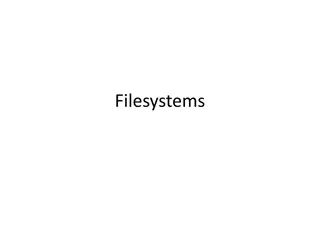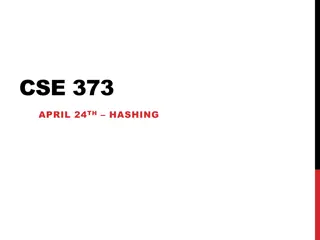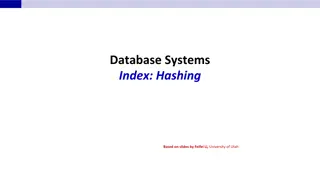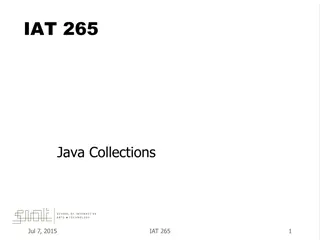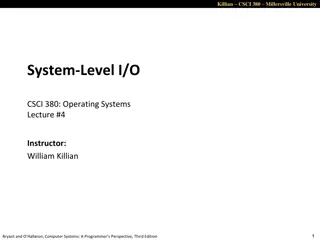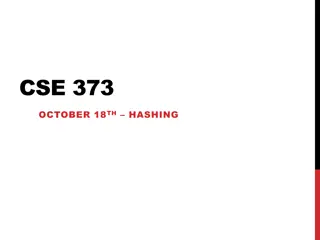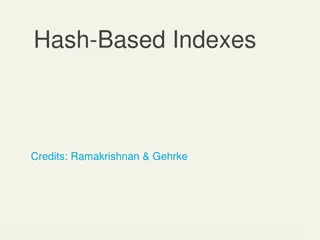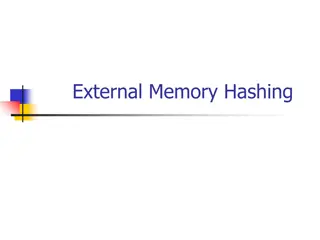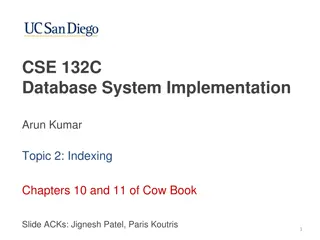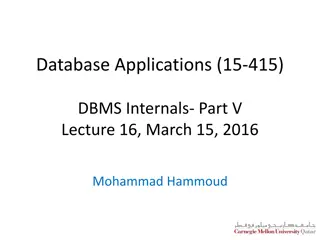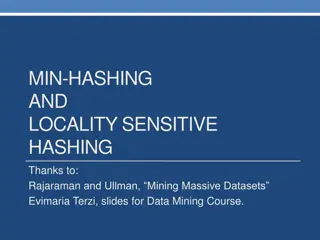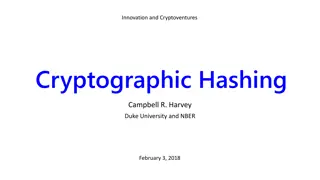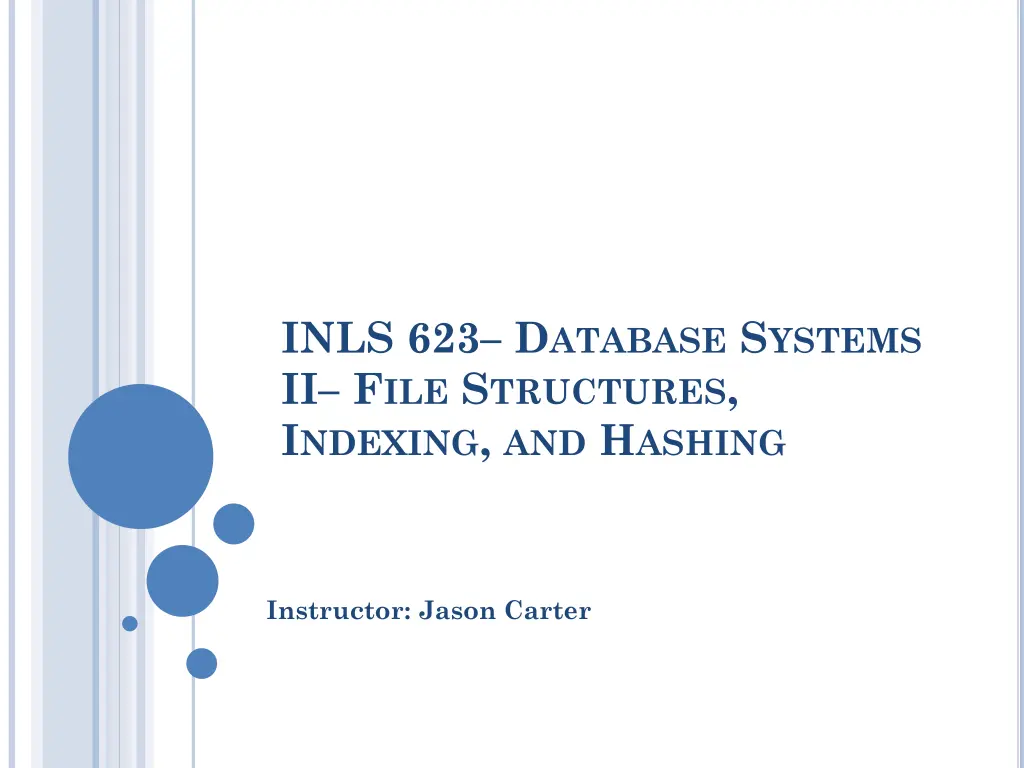
Understanding Database Data Storage and Retrieval Methods
Explore how databases store tables, manipulate data on disk, and efficiently find data using techniques like LIMIT keyword. Discover the impact of memory types such as RAM and SSD on data storage in databases.
Download Presentation

Please find below an Image/Link to download the presentation.
The content on the website is provided AS IS for your information and personal use only. It may not be sold, licensed, or shared on other websites without obtaining consent from the author. If you encounter any issues during the download, it is possible that the publisher has removed the file from their server.
You are allowed to download the files provided on this website for personal or commercial use, subject to the condition that they are used lawfully. All files are the property of their respective owners.
The content on the website is provided AS IS for your information and personal use only. It may not be sold, licensed, or shared on other websites without obtaining consent from the author.
E N D
Presentation Transcript
INLS 623 DATABASE SYSTEMS II FILE STRUCTURES, INDEXING, AND HASHING Instructor: Jason Carter
REVIEW Databases Logically Coherent Collection of related data Database has tables and there are relationships between the tables Where are those tables physically stored?
MEMORY How are those table stored in memory? Primary Memory Random Access Memory (RAM) Secondary Memory Disk (Hard Disk) Tape Solid State Devices (SSD) DVD/Blue Ray
FILE STORAGE Which type of memory do we typically store files in and why? Secondary Storage Secondary Storage is persistent and cheaper (than primary storage) Primary memory is faster We chose persistence and cost over speed
ITEMS TABLE Field item_id title long_text item_date deleted category Data Type int varchar text datetime Enum( Y , N ) int
FINDING DATA SELECT * FROM items WHERE category=4; How does MYSQL know where to find and return the data for this query? 1.Start at the beginning of the file 2.Read in enough to know where the category data field starts 3.Read in the category value 4.Determine if it satisfies the where condition 5.If it does add that record to the return set 6.If it doesn t figure out where the next record set is and repeat
FINDING DATA (CONTINUED) Database will read the entire data file off disk It does not matter how many rows satisfy the where clause This is very inefficient! Using a SQL command, how can we make this process more efficient?
MAKING DATA FINDINGMORE EFFICIENT Use the LIMIT Keyword SELECT * FROM items WHERE category=4 LIMIT 1; When does this query stop reading from disk? After the correct row is found. If row is at end of table, we still waste time reading the disk. Can we make reading data more efficient?
INDEX: MAKING DATA FINDINGMORE EFFICIENT An index is a data structure that makes finding data faster Adds additional storage space and writes to disk to maintain the index data structure Holds a field value, and pointer to the record it relates to Indexes are sorted What is a data structure? A way of organizing data in a computer so that it can be used efficiently
DATA STRUCTURES Array Hashtable/DictionaryAssociative Array Tuple Graphs Trees Object
ARRAY: DATA STRUCTURES A collection of elements (values or variables), each identified by at least one array index or key
INDEXING Have we ever used indexes before? When we set primary keys
ARRAYSFOR INDEXING Holds a field value, and pointer to the record it relates to Indexes are sorted Can an array be used for indexing?
B TREES FORINDEXING A tree data structure that keeps data sorted and allows searches, sequential access, insertions, and deletions in logarithmic time O(log N) basically means time goes up linearly while the n goes up exponentially. So if it takes 1 second to compute 10 elements, it will take 2 seconds to compute 100 elements, 3 seconds to compute 1000 elements, and so on.
B TREEAND INDEXING EXAMPLE Index for item_id 4 sorted values representing the range of item_ids The child nodes have the same range values last level nodes containing the final item_id value and pointer to the byte in the disk file the record lies
B TREEAND INDEXING EXAMPLE Looking for item_id 4 Is this really more efficient?
B TREEAND INDEXING EXAMPLE We needed to do 3 hops to get to item id 4. We had to look at the entire index for item_id Looking for item_id 20
B TREEAND INDEXING EXAMPLE We needed to do 3 hops to get to item id 20. # of hops required increases in a sort-of logarithmic manner with respect to database size Opposite to exponential growth Logarithmic shoots up in the beginning, but slows Exponential grows slowly at the beginning, but shoots up rapidly
INDEXING: GENERAL RULESOF THUMB Index fields in the WHERE CLAUSE of a SELECT Query User Table ID (INT) PK Email_address During login, MySQL must locate the correct ID by searching for an email Without an index, every record in sequence is checked until the email address is found
INDEXING: GENERAL RULESOF THUMB Should we add an index to every field? No, because indexes are regenerated during every table INSERT OR UPDATE Hurts performance
INDEXING: GENERAL RULESOF THUMB Only add indexes when necessary. Indexes should not be used on: Small tables Tables that have frequent, large batch update or insert operations Columns that contain a high number of NULL values Columns that are frequently manipulated
CREATEAN INDEX Queries performed on this table Look up a student by ID Search for students by last name List all students in a class
CREATEAN INDEX: LOOK UP STUDENT BY ID SELECT * FROM students WHERE ID = 1 Which column should have an index? ID
CREATEAN INDEX: SEARCH FOR STUDENTS BY LAST NAME SELECT * FROM students WHERE last_name = 'Smith' Which column should have an index? last_name
CREATEAN INDEX: LIST ALL STUDENTS INA CLASS SELECT * FROM students WHERE last_name = 'Smith' Which column should have an index? last_name CREATE INDEX by_last_name ON students (`last_name`);
CREATEAN INDEX: LIST ALL STUDENTS INA CLASS SELECT * FROM students WHERE Class = 6A' Which column should have an index? class CREATE INDEX by_class ON students (`class`);
MULTIPLE COLUMN INDEXES SELECT * FROM students WHERE class = '6A' AND last_name = 'Smith' Which column(s) should have an index? class, last_name CREATE INDEX by_class_and_last_name ON students (class, last_name);
MULTIPLE COLUMN INDEXES (CONT.) We cannot have an index on class and an multiple column index that uses class CREATE INDEX by_class ON students (`class`); CREATE INDEX by_class_and_last_name ON students (class, last_name); What do we do instead? DROP INDEX by_class ON students; CREATE INDEX by_class_and_last_name ON students (class, last_name);
MULTIPLE COLUMN INDEXES (CONT.) CREATE INDEX by_class_and_last_name ON students (class, last_name); We can index by: - Class only - Class and last_name - BUT NOT last_name only Indexes can only be used starting from the beginning
JOINS Students Grades
DISPLAY ALL GRADES FROM PARTICULAR CLASS SELECT * from students WHERE class = '6A' JOIN grades on grades.student_id = students.id What column should be indexed? student_id from the Grades table FK should be indexed CREATE INDEX by_student_id ON grades (student_id);



